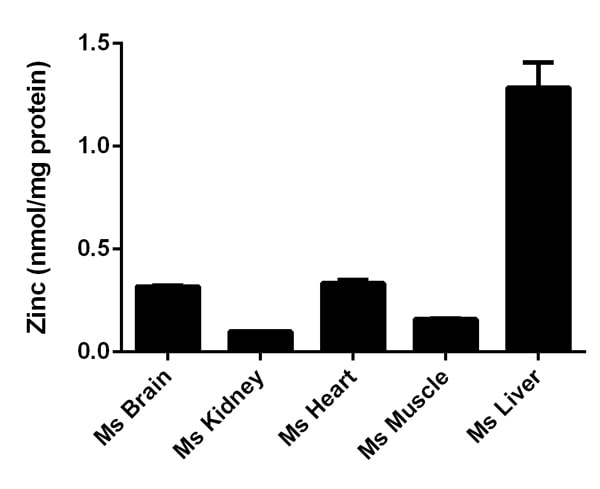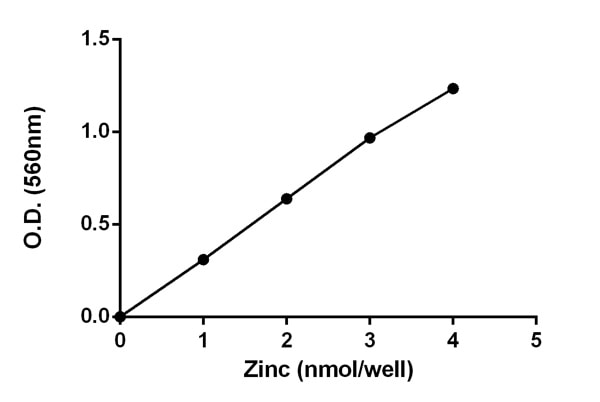Zinc Assay Kit (ab102507)
Key features and details
- Assay type: Quantitative
- Detection method: Colorimetric
- Platform: Microplate reader
- Assay time: 15 min
- Sample type: Cell culture media, Cell Lysate, Other biological fluids, Plasma, Serum, Tissue Extracts, Urine
- Sensitivity: 1 µM
Overview
-
Product name
Zinc Assay Kit
See all Zinc kits -
Detection method
Colorimetric -
Sample type
Urine, Serum, Plasma, Other biological fluids, Tissue Extracts, Cell Lysate, Cell culture media -
Assay type
Quantitative -
Sensitivity
> 1 µM -
Range
1 µM - 3 µM -
Assay time
0h 15m -
Product overview
Zinc Assay Kit ab102507 is a convenient colorimetric assay in which Zinc binds to a ligand with development of absorbance at 560 nm.
The zinc assay can be used with biological samples such as serum, plasma, csf or urine with detection sensitivity 0.2 µg/ml (~1-3 µM).
Zinc assay protocl summary:
- add samples and standards to wells
- add reaction mix and incubate for 10 min
- analyze with a microplate reader -
Notes
Zinc, a metallic chemical element, symbol Zn and atomic number 30 is chemically similar to Magnesium due to its similar size and sole oxidation state of 2+. Zinc is an essential mineral of great biological significance, because many enzymes require it as an essential cofactor.
-
Platform
Microplate reader
Properties
-
Storage instructions
Store at +4°C. Please refer to protocols. -
Components Identifier 100 tests TCA Clear 1 x 5ml Zinc Reagent 1 WM 1 x 16ml Zinc Reagent 2 Amber 1 x 4ml Zinc Standard Yellow 1 x 0.1ml -
Research areas
-
Relevance
Zinc, a metallic chemical element, symbol Zn and atomic number 30 is chemically similar to Magnesium due to its similar size and sole oxidation state of +2. Zinc is an essential mineral of great biological significance since many enzymes require it as an essential cofactor. Examples of zinc’s biological roles include signal transduction, gene expression, regulation of apoptosis, synaptic plasticity and prostate gland function. -
Alternative names
- Zn
- Zn++
- Zn2+
Images
-
 Functional Studies - Zinc Assay Kit (ab102507) Crawford, Aaron C et al., PLoS pathogens vol. 14,5 e1007013., Fig 2, doi:10.1371/journal.ppat.1007013Indicated strains were cultured in low zinc medium (SD0, pH ~4.7), exposed to 25 µM ZnSO4 and zinc acquisition determined at indicated time points by measuring how much zinc remained in the cell free supernatant. C. albicans wild type acquires all measurable zinc within 60 minute; zrt2Δ does not; complementation restored zinc acquisition to 68%. Experiment performed three times
Functional Studies - Zinc Assay Kit (ab102507) Crawford, Aaron C et al., PLoS pathogens vol. 14,5 e1007013., Fig 2, doi:10.1371/journal.ppat.1007013Indicated strains were cultured in low zinc medium (SD0, pH ~4.7), exposed to 25 µM ZnSO4 and zinc acquisition determined at indicated time points by measuring how much zinc remained in the cell free supernatant. C. albicans wild type acquires all measurable zinc within 60 minute; zrt2Δ does not; complementation restored zinc acquisition to 68%. Experiment performed three times -
Zinc measured in cell lysates showing quantity (nmol) per 1 mln of tested cells
-
Zinc measured in mouse tissue lysates showing quantity (nmol) per mg protein of tested sample
-
Standard curve (colourimetric) : mean of duplicates (+/- SD) with background substracted
-
Representative Standard Curve using ab102507.
















